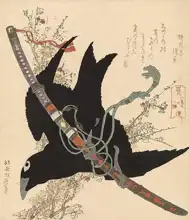About this finishing
Print. The image is printed on the top quality 10-ink HP Z9PS printer on HP matte 270 g / m2 paper. You can choose any size to an accuracy of 1 cm. A margin of 5 cm around the image is added to the size of the motif.


You can find a detailed description about our finishings
here.
The Little Raven with the Minamoto clan sword
Date:
1823Medium:
coloured woodcutLocation:
Pushkin Museum, Moscow, RussiaThe painting depicts a large black bird in flight, which looks energetic and dynamic. The bird's wings and beak are spread, and it appears to be captured at the moment of a cry or call. Its body is stylized with distinctive contours. The bird holds a Japanese sword in its beak, the blade of which is covered with an intricate pattern. The painting is executed in traditional Japanese style, with a background composed of delicate flowers and written characters that look as if they are part of an ancient manuscript or poetry.
This description was created by artificial intelligence, please be indulgent.
Hokusai painted picture The Little Raven with the Minamoto clan sword in 1823. Prevailing color of this fine art print is b&W and its shape is portrait. This art piece is located in Pushkin Museum, Moscow, Russia. This image is printed on demand - you can choose material, size and finishing.
Katsushika Hokusai (1760-1849). The Japanese artist, painter of ukiyo-e (pictures of the fleeting world) and illustrator known today mainly for his series 36 Views of Mount Fuji. He was born in Edo (now Tokyo). His most used technique was woodcut, which he subsequently transferred using colours onto paper or silk. The technique originated in the 8th century in China, and in the 17th century, it began to spread to Japan. Using this technique, officials, the life of upper classes, cities, travels, etc. were captured. The most famous representative of this series is a painting titled
the Great wave of Kanagawa. This xylograph was printed in approximately 5000 copies (therefore, there are different versions of the image). The image does not capture a tsunami, but rather okinami - literally translated, a folded wave on the open sea. Hokusai studied Japanese, Chinese, French and Dutch artwork and developed a distinctive style, which broke through the traditional and preconceived notions of what was then a Japanese painting. His work has had a global impact, and especially affected
Impressionists.

